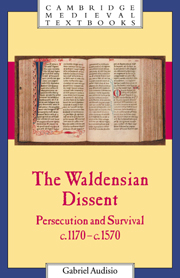Book contents
- Frontmatter
- Contents
- List of maps
- Preface
- Acknowledgements
- Introduction
- 1 1170 – 1215: decisive and purposive origins
- 2 The thirteenth century: the need to adapt
- 3 The fourteenth century: the challenge of believing differently
- 4 The fifteenth century: the risks of longevity
- 5 The constraints of a life in hiding
- 6 The need to organise
- 7 A culture of their own: the written and the spoken word
- 8 The sixteenth century: the end as a way forward?
- 9 Epilogue: the Waldensian Church
- Conclusion
- Bibilography
- Index
- Cambridge Medieval Textbooks
5 - The constraints of a life in hiding
Published online by Cambridge University Press: 05 June 2012
- Frontmatter
- Contents
- List of maps
- Preface
- Acknowledgements
- Introduction
- 1 1170 – 1215: decisive and purposive origins
- 2 The thirteenth century: the need to adapt
- 3 The fourteenth century: the challenge of believing differently
- 4 The fifteenth century: the risks of longevity
- 5 The constraints of a life in hiding
- 6 The need to organise
- 7 A culture of their own: the written and the spoken word
- 8 The sixteenth century: the end as a way forward?
- 9 Epilogue: the Waldensian Church
- Conclusion
- Bibilography
- Index
- Cambridge Medieval Textbooks
Summary
The original inspiration of Valdes was based on spreading the Word of God and encouraging men and women to be converted, and this shaped the lives led by his friends and disciples who became the movement's preachers. Their preaching obviously had to be open and public, and continued to be so as long as the decrees concerning their exclusion were not put into practice. During the thirteenth century, however, the Poor of Lyons were forced into hiding, as all surviving records confirm. Although their clandestmity was not an intrinsic part of the movement, it was to last as long as the movement itself, inevitably marking it so profoundly that it came to constitute an essential, even congenital feature. It is impossible to understand what these people's lives must have been like if, even momentarily, we lose sight of the fact that while there may have been periods of relative calm, persecution could start again at any moment. The truth of the matter is that if reprisals eased off from time to time, they never really came to an end. How can we possibly apprehend the complexity of the situation and the ambivalent attitudes which sometimes appeared, or evaluate how difficult relations were, making their survival over the centuries into a real exploit, if we fail to take into account one of the most deeply rooted aspects of the community's state of mind, that is, their awareness of being hunted down? Members had to be forever vigilant, measuring the importance of their words and deeds.
- Type
- Chapter
- Information
- The Waldensian DissentPersecution and Survival, c.1170–c.1570, pp. 87 - 109Publisher: Cambridge University PressPrint publication year: 1999



